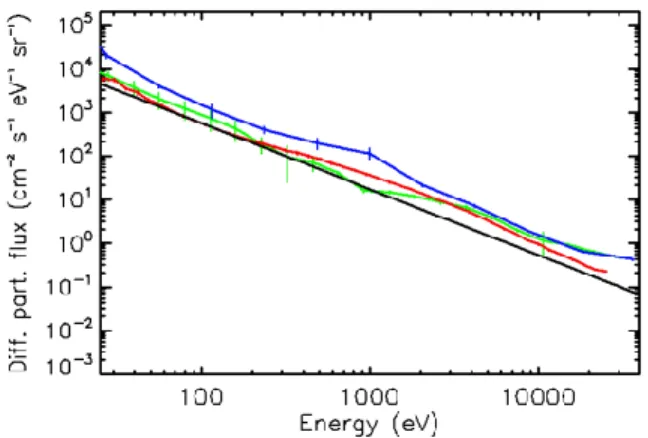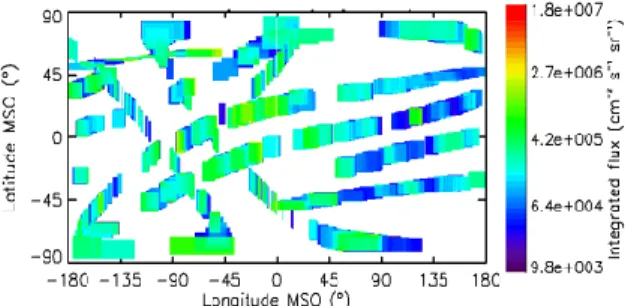HAL Id: insu-01599004
https://hal-insu.archives-ouvertes.fr/insu-01599004
Submitted on 30 Sep 2017
HAL is a multi-disciplinary open access
archive for the deposit and dissemination of
sci-entific research documents, whether they are
pub-lished or not. The documents may come from
teaching and research institutions in France or
abroad, or from public or private research centers.
L’archive ouverte pluridisciplinaire HAL, est
destinée au dépôt et à la diffusion de documents
scientifiques de niveau recherche, publiés ou non,
émanant des établissements d’enseignement et de
recherche français ou étrangers, des laboratoires
publics ou privés.
On Mars’ atmospheric sputtering after MAVEN first
two years
François Leblanc, Ronan Modolo, Shannon M. Curry, Janet Luhmann, Robert
Lillis, Jean-Yves Chaufray, Takuya Hara, James P. Mcfadden, Jasper S.
Halekas, Frank Eparvier, et al.
To cite this version:
François Leblanc, Ronan Modolo, Shannon M. Curry, Janet Luhmann, Robert Lillis, et al.. On Mars’
atmospheric sputtering after MAVEN first two years. European Planetary Science Congress 2017, Sep
2017, Riga, Latvia. pp.EPSC2017-58. �insu-01599004�
On Mars' atmospheric sputtering after MAVEN first two
years
Leblanc F. (1), Modolo R. (2), Curry S. (3), Luhmann J. (3), Lillis R. (3), Chaufray J.Y. (1), Hara T. (3), McFadden J. (3), Halekas J. (4), Eparvier F. (5), Larson D. (3), Connerney J. (6) and B. Jakosky (5)
(1) LATMOS/IPSL, UPMC Univ. Paris 06 Sorbonne Universités, UVSQ, CNRS, Paris, France, (2) LATMOS/IPSL, UVSQ Université Paris-Saclay, UPMC Univ. Paris 06, CNRS, Guyancourt, France, (3) UC Berkeley Space Sciences Laboratory, Berkeley, CA, USA, (4) University of Iowa, Department of Physics and Astronomy, IA, USA, (5) Laboratory for Atmospheric and Space Physics, University of Colorado Boulder, Boulder, CO, USA, (6) NASA Goddard Space Flight Center, MD, USA (francois.leblanc@latmos.ipsl.fr, Tel: +33 (0)144273753)
Abstract
Mars may have lost a significant part of its atmosphere into space along its history, in particular since the end of its internal dynamo, 4.1 Gyr ago. The sputtering of the atmosphere by precipitating planetary picked up ions accelerated by the solar wind is one of the processes that could have significantly contributed to this atmospheric escape. We here present a two years base analysis of MAVEN observation of the precipitating flux, in particular the dependency of the precipitating intensity with solar zenith angle and used this measurement to model the expected escape rate and exosphere induced by this precipitation.
1. MAVEN measurements
In order to reconstruct the flux of precipitating picked-up ion measured by MAVEN, we used the same approach as in [1], that is, we used all available measurements of the ion mass and energy distributions realized between 200 and 350 km in altitude by SWIA (cs product) and STATIC (ca and d0 products). We selected the anodes covering the 75° cone angle oriented along the zenith direction and reconstructed the energy distribution. Figure 1 displays the average precipitating flux measured by MAVEN SWIA and STATIC during the first two years of MAVEN operations (between 12/02/2014 and 10/24/2016).
Figure 1: Differential particle flux of the precipitating pick-up ion as measured by MAVEN between 200 and 350 km in altitude during the 12/2014-10/2016 period. Red line: SWIA cs, blue line: STATIC ca, green line: STATIC d0 15-17 amu mass range, black line: theoretical predicted flux (Wang et al. 2015). As shown in Figure 1, there is globally a good agreement between the measured flux by SWIA and STATIC, knowing that SWIA field of view allows a better coverage of the cone angle pointing towards the zenith than STATIC. Moreover, the comparison between STATIC d0 product for masses between 15 and 17 amu and SWIA cs suggests that most of the precipitating ion measured by SWIA with energy larger than few tens of eV are O+ ions. Compared to
the predicted energy flux distribution [2], Figure 1 highlighted the good agreement between prediction and measurements.
EPSC Abstracts
Vol. 11, EPSC2017-58, 2017
European Planetary Science Congress 2017 c
Figure 2: Integrated precipitating flux measured by MAVEN (SWIA cs) during the 12/2014-10/2016 period plotted vs MSO latitude and longitude. The subsolar point is at 0°,0°.
In Figure 2, we plotted the integrated flux in a MSO longitude/latitude frame. This shows that the precipitating flux is organized between day and night sides with a 1.7 times higher intensity of the dayside precipitating flux.
2. Induced atmospheric escape
Reconstructing the precipitating flux between day and night sides, we simulated the fate of precipitating pick-up O+ ions into Mars' atmosphere usingExospheric Global Model (EGM) [3] coupled to LMD-GCM [4] in order to calculate the induced exosphere and atmospheric escape by the precipitating ion (Figure 1, red line). EGM is a multispecies parallelized 3D model describing, for any season and solar conditions, how energetic ion will interact with Mars' upper atmosphere (composed of CO2, CO, O, N and N2) by transferring energy and
momentum to the atom and molecule and ejecting atmospheric species into the exosphere. To describe the collision, we used at low energy the universal collision scheme of [5] and at high energy molecular dynamic scheme [6] in order to take into account the possibility of molecular dissociation.
3. Conclusion
Based on the average measured precipitating flux during the first two years of MAVEN observations, and using a model to determine the potentially induced atmospheric escape, we concluded that 5×1023 O/s, 8×1022 CO
2/s, 4×1022 CO/s, 1×1023 C/s,
1.6×1024 N/s and 4×1023 N
2/s should have escaped
Mars' atmosphere between December 2014 and October 2016.
Acknowledgements
FL, JYC and RM acknowledge the support of the ”Système Solaire” program of the French Space Agency CNES and the Programme National de Planétologie and Programme National Soleil-Terre. This work is also part of HELIOSARES Project supported by the ANR (ANR-09-BLAN-0223) and ANR MARMITE (ANR-13-BS05-0012-02). Authors also acknowledge the support of the IPSL data center CICLAD for providing us access to their computing resources and data. The results of the simulations presented in this paper can be requested to FL.
References
[1] Leblanc F., R. Modolo, S. Curry, J. Luhmann, R. Lillis, J. Y. Chaufray, T. Hara, J. McFadden, J. Halekas, F. Eparvier (2015), et al., Mars heavy ion precipitating flux as measured by Mars Atmosphere and Volatile EvolutioN, Geophys. Res. Lett., 42, doi:10.1002/2015GL066170. [2] Wang, Y.-C., J. G. Luhmann, X. Fang, F. Leblanc, R. E. Johnson, Y. Ma, and W.-H. Ip (2015), Statistical studies on Mars atmospheric sputtering by precipitating pickup O+: Preparation for the MAVEN mission, J. Geophys. Res.
Planets, 120, 34–50, doi:10.1002/2014JE004660.
[3] Leblanc F., Modolo R., Chaufray J.Y., Leclercq L., Curry S., Luhmann J., Lillis R., Hara T., McFadden J., Halekas J., Schneider N., Deighan J. and B. Jakosky, Mars' exosphere observation and modelling: HELIOSARES view of MAVEN's measurements, J. Geophys. Res., Submitted, 2017.
[4] Chaufray J-Y, Gonzalez-Galindo F., Forget, F., Lopez-Valverde M., Leblanc F., Modolo, R., Hess, S., M. Yagi, Blelly, P-L., Witasse, O. (2014), 3D Martian Ionosphere model : II Effect of transport processes without magnetic field, Journal of Geophysical Research: Planets, 119 (7), 1614-1636. doi: 10.1002/2013JE004551
[5] Lewkow N.R. and V. Kharhenko (2014), Precipitation of energetic neutral atoms and induced non-thermal escape fluxes from the Martian atmosphere, ApJ, 790, doi:10.1088/0004-637X/790/2/98.
[6] Leblanc, F., Johnson, R.E., (2002), Role of molecular species in pickup ion sputtering of the Martian atmosphere. Journal of Geophysical Research 107.

